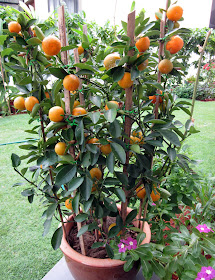Potted Calamansi plants (Citrofortunella microcarpa, limau kasturi in the Malay language) are ubiquitous during the celebration of the Chinese Spring Festival. I have several pots left from previous years. My calamansi plants have a magnetic appeal for all sorts of critters.
The caterpillar of the Lime butterfly (Papilio demoleus malayanus) crawled all over the plant in search of the juiciest leaves to feed on. It masticated voraciously as evidenced by the jagged edges of gnawed leaves and its droppings. It even had the audacity to chill out on my prime fruits besides casually depositing its droppings. The outcome of which is a very suggestive pose. Honest, I didn't staged this scene. Actually this particular scene started me on the thread of this post.
This newly emerged Lime butterfly, settled on a leaf of the hedge (Baphia nitida) to dry out and warm up.
Here under the bright morning sunshine it flapped its wings up and down with slow incisive motions. I can almost feel it purring with pleasure.
While strutting its stuff, its underside was displayed in all its 'batik' glory.
A Green Shield Bug with mean beady eyes laid seige on its territorial turf; leaves that had yellowed and had seen better days.

However it then turned around to shrewdly contemplate its next course of action ...

on moving to greener pastures.
Somewhere else on the shrub, a tiny ladybug quietly tried to navigate its way between the leaves.

A Green Shield Bug with mean beady eyes laid seige on its territorial turf; leaves that had yellowed and had seen better days.

However it then turned around to shrewdly contemplate its next course of action ...

on moving to greener pastures.
Somewhere else on the shrub, a tiny ladybug quietly tried to navigate its way between the leaves.

This Pied Shieldbug (Sehirus bicolor) is the new kid on the block, but had snugly ensconsed itself in lush lime foliage.
It also wanted to stake its claim on a piece of prime property and had chosen this promising green citrus, hugging it covetously.
On the other hand, ants do not partake of foliage or fruits, instead they have their hands full gathering nectar and pollen from the Calamansi flowers.
The larvae of some citrus Leafminers left evidence of their nefarious activities on the undersurfaces of some lime leaves.
On the other hand, ants do not partake of foliage or fruits, instead they have their hands full gathering nectar and pollen from the Calamansi flowers.
The larvae of some citrus Leafminers left evidence of their nefarious activities on the undersurfaces of some lime leaves.
This plant is a legacy from last Chinese New Year's purchase of ornamental plants. My Calamansi plants have served me well. I harvest the fruits almost daily to zest up my juices, cocktails and sambal belacan. It is most flavourful as its fragrance and aroma is unique unlike Citrus aurantifolia (Limau nipis in Malay) which is just plain sour.
A platter of oranges, calamansi and bananas ready to be blended. As many creepy crawlies have a run all over the plant and fruits, I scrub the fruits thoroughly with soap before using.

The fruit platter makes five glasses of refreshing fruit juices and is loaded with oodles of vitamin C. As I sipped the juices, I can feel its goodness coursing through me :)






























































